WW1 in Alsace - Linge Battle - 63rd Anti Aircraft Regiment - 96th poste semi-fixed
The men of the 96th poste semi-fixed
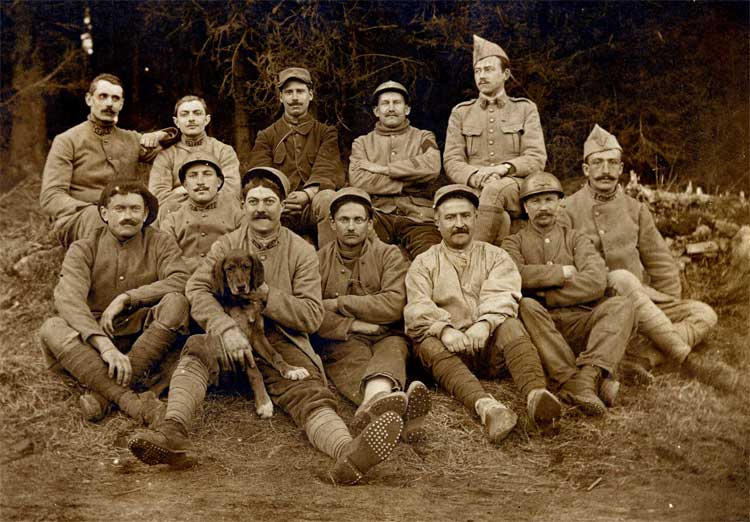
This photo of The men of the 96th poste semi-fixed was taken after October 14th, 1917. Most of these soldiers are attached to the 63rd Anti Aircraft regiment, now the 96th poste semi-fixed 96 was attached to this regiment on October 1st, 1917, and the Sergeant Amédée LIESSE, present on the photo, was in leave from 1st to 14 October.
The Identical clothing, details dress, and accessories worn by the men on the 2 photos would suggest these photos were taken in a few moments later.
The clean soles of shoes, the absence of mud on an apparently trampled ground allow to say that the weather was relatively dry for several days. The absence of great-coat lets suppose that the temperature was clement.
According to a professional of the National Service of Forests, the background vegetation, which lets appear some dead wood and rocks, looks like a vegetation such as we meet it after the winter and before the resumption of vegetation in spring.
All this let suppose that these photos were taken at the beginning of the spring, 1918.
In addition, according to the same professional of the National Service of Forests, trees are fir trees and not pines, photos would have been taken thus in a "fresh" place, rather exposed to the North, finally the big size of trees allows to say that this place is sheltered from storms.
The professional of the National Service of Forests thinks that this vegetation could again be in place nowadays.
Comments below have been done by courtesy of Yves FINEL
A chameleon troop for uniforms.
The reference horizon-blue "1916" is the lieutenant JOLLY. Only 5 soldiers are in this colour ; five others are in a colour close to the horizon-blue. Their uniform is thus oldest of almost one year or two, two particular cases the "colonial" soldier who has to be mustard normally and the "unclassifiable" soldier in militarized jacket or grey of bluish iron.
Nobody wears rollers on shoulder, they are artillerymen, not infantrymen.
All men wear beautiful mustaches, while the prescriptions since attacks with gas towards Ypres had obliged the soldiers to cut it off. They would not ever have undergone attacks with gases ?
This photo gives a feeling of relative freedom for uniform ; to put in connection with the history of The 63rd Anti-Aircraft regiment where it is said that these units recently created, are not also essential as artillery formations on the strategic and administrative plan.
They depended on the good will of this administration both for equipments and for provisioning : we addressed the estate management of the better supplied nearby classic artillery. These antiaircraft units had to manage alone to fight and survive... This would partially explain this patchwork. We can say that they were the slightest concern for the army in this domain.
Three men don't look the picture of health These men who seem tired it can be fortuitous, perhaps not completely. Indeed, always in touch with the history of the The 63rd Anti Aircraft regiment, these antiaircraft units were composed by staffs who for the greater part were relatively unfit of the fights of first lines (infantry, cavalry or artillery). They came from everywhere, from all the weapons. They had been soldiers, had been wounded or weakened by the diseases, sometimes they were too old, this could explain the presence of these three soldiers with this face so characteristic.
Courtesy of Yves FINEL
![]()
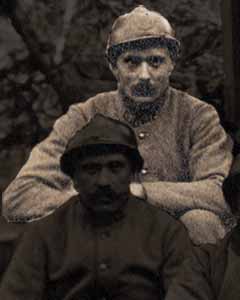
You have information on this artilleryman of the 96th poste semi-fixed of The 63rd Anti Aircraft regiment ?
Please Email me.
Click photos to enlarge
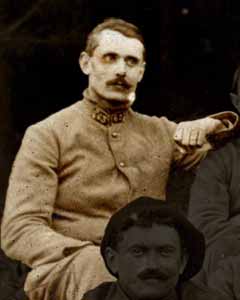
This artilleryman has a classic uniform : jacket pattern 1914 or 1915, close to the horizon-blue ; badges of collar looking like those prescribed in November, 1914, horizon-blue number and braids, these badges are red (artillery), he wears the statutory tie.
Notice the dug features of the face, we can think that this man is not as fit as a fiddle.
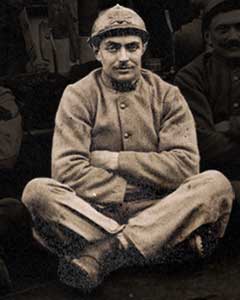
You have information on this artilleryman of the 96th poste semi-fixed of The 63rd Anti Aircraft regiment ?
Please Email me.
Click photos to enlarge
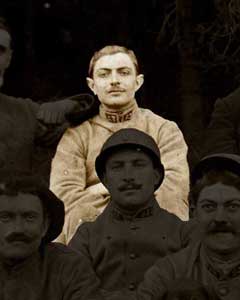
This artilleryman has a classic uniform : jacket typifies 1914 or 1915, close to the horizon-blue but clearer ; the same red badges, he wears a tie.
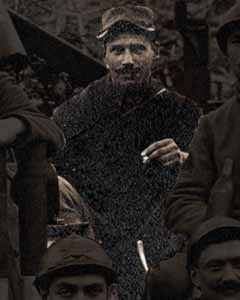
You have information on this soldier ?
Please Email me.
Click photos to enlarge
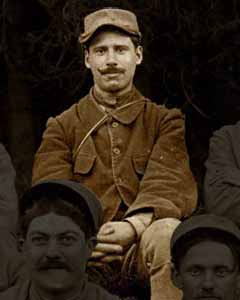
This soldier is out of the ordinary : a velvet uniform, or a militarized civil garment ? Buttons are not statutory (flat buttons with holes to cross the threads), maybe a blue chasseur's jacket (grey of bluish iron) with turned down collar, modified with two pockets on the breast not statutory. Everything seems dark blue to him, even the trousers.
The very weary kepi pattern 1884 modified on 1914, horizon-blue ; the peak always caught in the middle gives it a net inflexion as beak of duck, he wears the statutory tie.
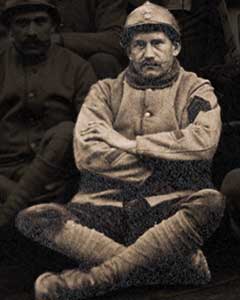
Click photos to enlarge
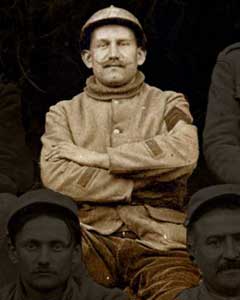
This artilleryman wears the statutory sweater with big rib of the army, the collar turned down certainly to avoid that the straight collar of the jacket of type 1914 or 1915 scrapes. trousers dark blue (grey of bluish iron) of artilleryman of 1914, maybe of velvet.
Two chevrons, rather red because of the difference of tint of corporal's chevrons ; as a rule, according to the regulation, those should have to be of the blue woolen , and three blue chevrons on the left hand (salvage of fabrics of grey uniform of bluish iron) for two years of presence in the front line (1 for the first 12 months frontally, and 1 for each 6 months supplementary). He have no chevron of wounds on the right arm.
He seems to be sure of himself, certainly a character.
You have information on this Lieutenant of The 63rd Anti Aircraft regiment ?
He could be :
- The Lieutenant JOLLY, commanding the poste 96th poste semi-fixed
- The Lieutenant THUON, commanding the sector 2 of the 63rd Anti Aircraft regiment.
Please Email me.
Click photo to enlarge
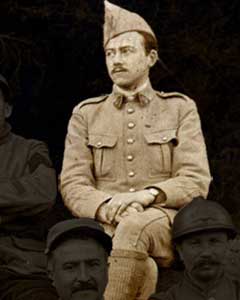
The officer, the Lieutenant JOLLY ? The leader, the eyes turned to the left "on the blue line of Vosges ?"
Everything is statutory, even in the forest, with a touch of elegance. We distinguish his lieutenant's gold-coloured stripes pointed upward at sleeves. We find his rank on it V of the forage cap model 1915 with red piping of the artillery.
horizon-blue jacket for officer, collar of Saxony with on points the distinctive of the regiment certainly red. Curiously he wears knitted puttees ? ! Red piping of the pants is visible.
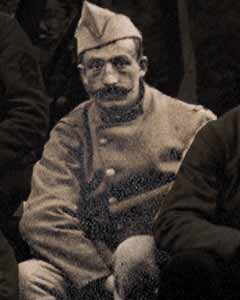
You have information on this artilleryman of the 96th poste semi-fixed of The 63rd Anti Aircraft regiment ?
Please Email me.
Click photos to enlarge
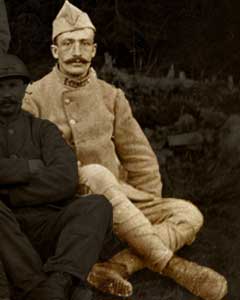
This soldier is equipped modern. The forage cap is of the model 1915 without rank (private) but with red piping for the artillery. He wears horizon-blue or mustard calves' strips and statutory shoes.
In fact and it is the novelty there, he does not wear a pea jacket but a paletot of the colonial ; can be horizon-blue much more certainly of color typical mustard ; with a buttoning moved towards the right. Can be an inheritance of its passage in the colonial artillery, because of its red badges, unless comes from a regiment of colonial infantry.
His face is marked, he seems tired.
You have information on this soldier ?
Please Email me.
Click photo to enlarge
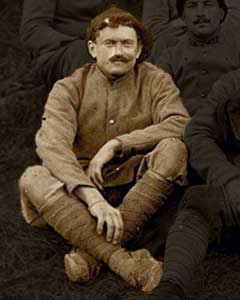
This soldier wears a rather classic uniform, a pea jacket 1914 or 1915, the distinctives of the collar are invisible. His calves are covered with darker strips (dark blue faded ?), those of 1914 were grey of bluish iron. They are rolled up well and crossed according to the rules stipulation, careful this soldier. On the other hand he is more than likely that he is put shoes by clogs, can be of rope-soled sandals, but it is not sure, the right shoe seems very soft. His hat is a dark blue beret (grey of bluish iron), or of chasseur (they often look wider) or of mountain infantry regiments.
He wears a net fitted well to the right hand : would it be its identification plate ? At this time there there is only one on the wrist.
He is smiling.
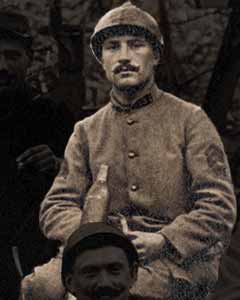
You have information on this artilleryman of the 96th poste semi-fixed of The 63rd Anti Aircraft regiment ?
Please Email me.
Click photos to enlarge
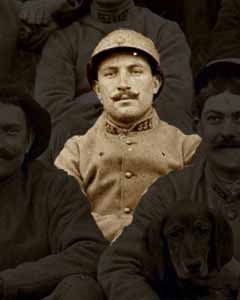
This soldier wears a pea jacket 1914 or 1915, red badges. The helmet wears the grenade and its two statutory crossed gun of the artillery.
He is serene.
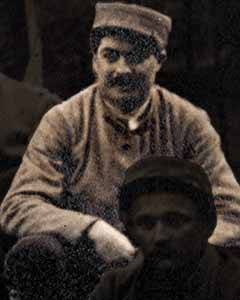
You have information on this artilleryman of the 96th poste semi-fixed of The 63rd Anti Aircraft regiment ?
Please Email me.
Click photos to enlarge
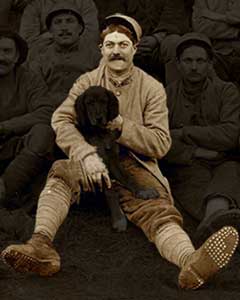
Nice this artilleryman, with the very attentive mascot with white gloves.
The kepi model 1884 modified 1914 is disordered, played up. He does not apparently wear a tie, we see the first button down from its shirt. The pea jacket is the type 1914 or 1915. Pants season velvet, dark (blue or brown ?). His leggings are rolled up well crossed, of clear color, horizon-blue.
Shoes are statutory, but the type is not déterminable. The lace-up boots nicknamed "godillots" from the name of the supplier of the troop at least since 1870 is with 6 eyelets and 88 or 98 nails ! (model 1893), either 7 eyelets and a rivet, more comfortable, 58 or 88 nails all the same (model 1912), everything is of color dark fawn. At the time of the photo we can think that it is rather the model 1912.
He is smiling our soldier.
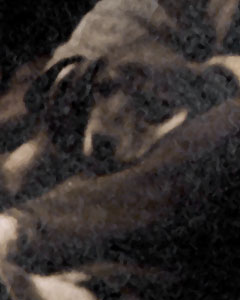
The mascot of the 96th poste semi-fixed of The 63rd Anti Aircraft regiment
Click photos to enlarge
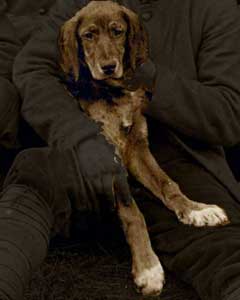
![]()
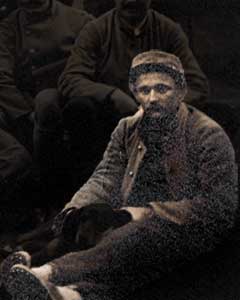
You have information on this artilleryman of the 96th poste semi-fixed of The 63rd Anti Aircraft regiment ?
Please Email me.
Click photos to enlarge
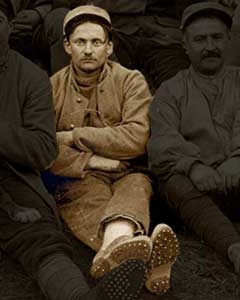
We are struck by his sadness, this unfortunate soldier is really fed up ! Everything says it : his lost glance; his untidy hair ; his face without expression; his not buttoned pea jacket 1914 or 1915 ; his pants season which is not held by calves' strips. He does not even wear brodequins but certainly civil studded clogs.
Somewhere, he doubtless wants to show his opposition to this war situation by the carelessness. This impression of tiredness, refusal of the war, is strengthened by the crossed arms (withdrawn ?). Psychologically he seems to have given a lot, will it be capable of resisting morally on another one year or two? Nobody knows it...
He wears a ribbed sweater of the army. He is wearing a kepi 1884 modified on 1914, very behind on the skull. His uniform is everywhere with the same tint, close to the horizon-blue. We can distinguish the bottom of its pants and the internal facing in ecru or blue linen, it is rather rare.
You have information on this soldier ?
Please Email me.
Click photo to enlarge
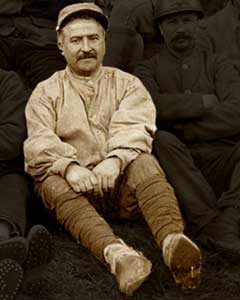
He could almost be a part of the reservists this brave soldier, soundly about forty, in the greying temples.
There also a certain carelessness in the clothing. He wears the same kepi, a shirt of the army. It is not striped but it existed. The pants are close to the horizon-blue, calves' strips voluntarily loosen, that crumples a little, but let be relaxed. Clogs, without nail, strengthen the impression of nonchalance.
He is smiling this soldier, a nice provincial note.
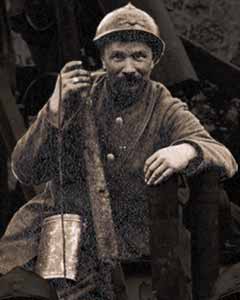
You have information on this artilleryman of the 96th poste semi-fixed of The 63rd Anti Aircraft regiment ?
Please Email me.
Click photos to enlarge
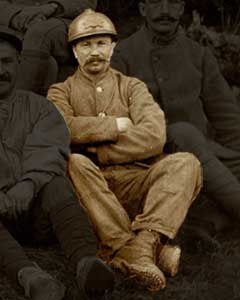
A smiling, classic soldier with his uniform close to the horizon-blue. Helmet of statutory artilleryman : the grenade and both crossed gun. He wears a pea jacket of type 1914 or 1915 with hardly visible badges. He does not wear calves' strips.
On the photo of the group with his cannon, this soldier carries his very visible gas mask. It is certainly a question of it oval in the form of bean mask TN's box (linen cone with soaked compress and separate glasses distributed in January, 1916) rather than it sub-oval (first model) of mask M2's box distributed in January, 1916.
The model M2 is a linen hood which integrates the glasses to the cone of the TN, in a single piece. During the war this old box in the form of bean also served for storing the mask M2 more safe. This masks' boxes have never found a good place on the harness of the "poilus", they carted around them suspended by a length of string or a small chain from the belt... It beat legs during walking and fights.
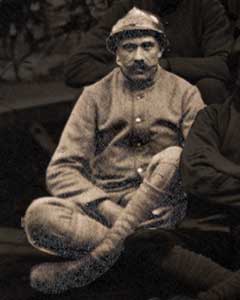
You have information on this artilleryman of the 96th poste semi-fixed of The 63rd Anti Aircraft regiment ?
Please Email me.
Click photo to enlarge
This soldier wears a classic horizon-blue pea jacket 1914 or 1915. He is wearing an artilleryman's helmet with both crossed gubs. He arranged his horizon-blue calves' strips of a way perfectly crossed.
The face is impassive, it is impressive.
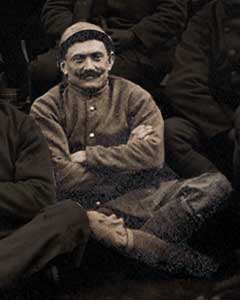
You have information on this artilleryman of the 96th poste semi-fixed of The 63rd Anti Aircraft regiment ?
Please Email me.
Click photo to enlarge
It is a smiling soldier. He wears a pea jacket 1914 or 1915 of a color close to the horizon-blue.
He wears calves' strips the color of which seems to be grey of bluish iron.
Comments above have been done by courtesy of Yves FINEL
